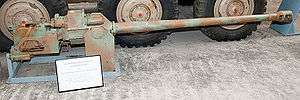5 cm KwK 39

The 5 cm KwK 39 L/60 (5 cm Kampfwagenkanone 39 L/60) was a German 50 mm caliber gun used during the Second World War, primarily as the main armament of later models of the German Panzerkampfwagen III tank from 1941 onwards.[1] It was introduced to combat the well-armoured T-34 and KV-1 tanks encountered on the Eastern Front, although it was only partially successful in its role, later being superseded by the 7.5 cm KwK 40 L/43.
It was also mounted on the SdKfz 234/2 Puma armoured car.
History
It was developed as a variant of the 5 cm PaK 38 towed anti-tank gun.[2] On the Panzer III, it replaced the 5 cm KwK 38, which had an L/42 caliber length and a lower muzzle velocity. However, even the 5 cm KwK 39 gun with a longer barrel, higher velocity and more penetration was not sufficient against newer Soviet T-34 and KV-1 tanks. Therefore, as time went on, the Panzer III was no longer effective as a medium tank that could engage in fights with enemy tanks. So, a new role for the Mark III tank was found. On the Panzer III, the 5 cm KwK 39 was phased out in favor of the shorter but larger caliber 7.5 cm KwK 37 L/24 low velocity guns[1] that could fire more effective HE and HEAT rounds. HE howitzer type rounds with high explosive forces and shrapnel were very effective against infantry, machine gun nests and towed enemy guns on the battlefield. However, early HEAT rounds were somewhat unreliable. They were useful against hardened fortifications and had a good but limited capability against enemy armor. Thus, they were used against enemy tanks mostly in an emergency. With these changes, the Panzer III with the 7.5 cm KwK became an infantry support tank late in its career, while the new, much more capable 7.5 cm KwK 40 L/43 was mounted on the larger Panzer IV Ausf. F2 (and the longer L/48 on subsequent Ausf. versions) to fight the KV and T-34 tanks.
Ammunition
Average penetration performance established against rolled homogenous steel armor plate laid back at 30° from the vertical.[3]
- PzGr (Armour-piercing)
- Weight of projectile: 2.06 kg (4 lb 9 oz)
- Muzzle velocity: 835 m/s (2,740 ft/s)
| 100 m | 500 m | 1000 m | 1500 m | 2000 m |
| 67 mm | 57 mm | 44 mm | 34 mm | |
- PzGr. 39 (Armour-piercing, capped, ballistic cap)
- Weight of projectile: 2.06 kg (4 lb 9 oz)
- Muzzle velocity: 835 m/s (2,740 ft/s)
| 100 m | 500 m | 1000 m | 1500 m | 2000 m |
| 69 mm | 59 mm | 48 mm | 37 mm | |
PzGr. 40 (Armour-piercing, composite, rigid)
- Weight of projectile: 0.9 kg (2 lb 0 oz)
- Muzzle velocity: 1,180 m/s (3,900 ft/s)
| 100 m | 500 m | 1000 m | 1500 m | 2000 m |
| 130 mm | 72 mm | 38 mm | ||
- PzGr. 40/1 (Armour-piercing, composite, rigid)
- Weight of projectile: 1.06 kg (2 lb 5 oz)
- Muzzle velocity: 1,130 m/s (3,700 ft/s)
| 100 m | 500 m | 1000 m | 1500 m | 2000 m |
| 116 mm | 76 mm | |||
- 5 cm Sprgr.Patr.38 (High explosive) [4]
- Weight of projectile: 1.82 kg (4 lb 0 oz)
- Muzzle velocity: 550 m/s (1,800 ft/s)
Vehicles mounted on
- Panzerkampfwagen III (Sd. Kfz. 141/1) Ausf. J to M (serial production).[1] Several earlier models were re-equipped with this gun.
- Sd. Kfz. 234/2 Schwerer Panzerspähwagen "Puma"
Aerial version
Bordkanone-series BK 5 heavy-caliber autocannon
See also
Weapons of comparable role, performance and era
- British Ordnance QF 2-pounder
- Soviet 45 mm anti-tank gun M1937 (53-K)
- United States 37 mm Gun M3
References
- 1 2 3 Rottman, Gordon L. (2008). M3 Medium Tank Vs Panzer III: Kasserine Pass 1943. Osprey Publishing. p. 20. ISBN 978-1-84603-261-5.
- ↑ Rottman, Gordon L. p.4-5
- ↑ Ankerstjerne, Christian. "Armor Penetration Table". http://www.panzerworld.com/. External link in
|website=(help) - ↑ "Germany's 50 mm Guns". http://www.wwiivehicles.com/. Retrieved 24 October 2014. External link in
|website=(help)
External links
| Wikimedia Commons has media related to 5 cm KwK 39. |
